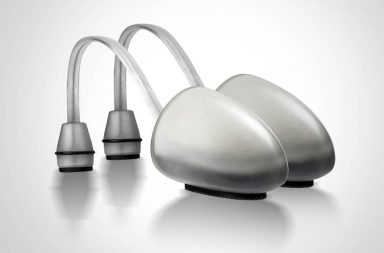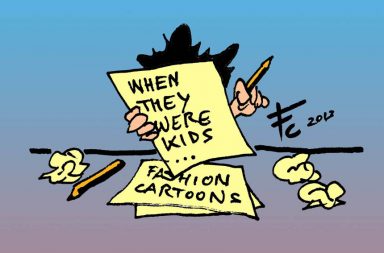At So Catchy! we love it when we come upon technology blended with design, fashion and art, creating new and amazing concepts. When we found out about NECLUMI, we started looking into the people behind the innovative project and discovered PANGENERATOR, four creative minds, experts in various fields who aren’t afraid to try new things and who find themselves working in a discipline where it’s all been done before. Piotr Barszczewski, Jakub Koźniewski, Krzysztof Cybulski, and Krzysztof Goliński, the four young minds from Poland behind NECLUMI, are musicians, programmers, artists, and work in artificial intelligence. The doors are open to a new world of research into wearable technology, fashion and projections on the body. We spoke with Jakub Koźniewski and this is what he had to say:
NECLUMI – a probable future of jewellery? from ◥ panGenerator on Vimeo.
So Catchy!: First of all congrats on your amazing work. How did the idea for NECLUMI come about?
Jakub Koźniewski: It’s very hard to point directly to where the ideas came from, but I think because we’ve been working in some different fields in parallel, we’d been doing some projects with wearable technology previously, we have been aware of wearable technology, it is something we have been interested in for some time and then we also played a bit with projection mapping, so it kind of combined in my head, we’ve got wearable technology and you could do really great things with projections. I realized there is a technology called pico projection, that is not that very commonly used, not very many people are aware of projectors of this size but they are already on the market. They are far from being perfect but I think they will rapidly improve in a few years from now.
So these projectors are very tiny and I thought of linking them with wearables, so you could put the projections onto yourself. Because there were other projects about projections on the body, the most famous one with this technology, at least recently I think, is the project with virtual make-up, called Omote, it appeared when I had been working on NEKUMI for sometime, but all the projections on the body are a static thing, the model is sitting, she or he could just move his or her head around, but otherwise, a studio thing, it is just an artistic experiment; it’s a different thing. But the important thing for us was, what part of the body we should really project on, it is not that easy, I mean, if you think that the neck is naturally the place where you could put projections, that wasn’t so obvious to us. We had to do some experiments.
I just bought some projectors that were available on the market, I created 3D printed holders attached to the iPhone, a regular HDMI cable and the software that allows the projections to be reactive to movement and sound or whatever you like. This was the process of thinking behind NECLUMI. If you want to really make something happen, and if it’s something new, never done before, you should work hard to make it happen and you have to work in many parallel fields, new ideas are always reconfigurations of existing ones, the novelty factor comes often from crossing two different fields, two different disciplines.


SC!: What implications could the Neclumi project have for the future of wearables and fashion?
JK: I think it may have some implications. There is already some interest from the fashion industry; it is a funny project because it’s appeals to so many different communities. Obviously, it appeals to some tech communities, geeks, nerds, it’s a technical gadget, there’s an interest in them, but then we have interest from the jewellery and fashion industries as well. From the fashion point of view it really fits well with all the experiments that are going on right now, like reactive dresses, reactive to light, LEDs… There is a trend towards technology in fashion, where NECLUMI is kind of involved. And it could show the way or inspire so many other different projects about projections on the body. It is also mobile so it is wearable, another important trend right now. The projectors are getting smaller and the technology is improving quickly so, maybe soon, it could be commercialized. Right now it is too early to say that this will be something that everybody will wear, but maybe in a few years it will be small enough and simple enough to become a part of a dress for example. Probably next year we will see NECLUMI on a catwalk or worn by a singer on stage. It is not an everyday basic, it’s more something you would wear in the evening, for special events, parties, etc.
SC!: Are you interested in continuing to work and investigate in this field?
JK: Yes, I will continue working in this field. First of all, I have really enjoyed working on the NECLUMI project, and now it is like a rudimentary version. Because of the pico projection size, it’s not really comfortable yet. You have to wear it with your iPhone, there is a cable involved and it is very far from being a commercial product. But, obviously, I’m interested in trying to take steps in this direction. As I said, I’m talking with some high fashion designers who want to use it in their fashion shows for example and also with some NYC stage artists, and in these cases NECLUMI could be used right now. I like to work in customizing the software to adjust it for different possibilities, different shows, because the appearance of the visuals could be adapted to the particularities of the artist. These are the fields I hope to continue working in for a few months. And of course, I am open for collaborations!


SC!: You are a multidisciplinary team, why do you think collaborations between different fields are important for improving projects?
JK: Yes, we are a multidisciplinary team. There are four people on the team, directly in this project I work with Piotr Barszczewski and also a little help from Krzysztof Goliński and Krzysztof Cybulski. We needed a bit of 3D printing which is hard to do on your own, a bit of coding so I needed a bit of help. I was able to really hack all the things by myself but there were a lot of projects that we were working on in the meantime where this collaboration is kind of vital. You’ve got a sound artist, a musician, on our team as well. A lot of projects we were working on involved sounds, most of the projects we do involve some mechanics, engineering, designing crazy constructions and there’s a lot of work. You cannot handle it all by yourself, so most of the work is multidisciplinary and collaborative, and this collaboration I think pushed us as a group a long way.
SC!: Where do you find inspiration?
JK: This is a tricky one. I shouldn’t focus on a single field, it is not like you are a programmer and you are only thinking of coding, sitting and writing code. You have to be very aware of what’s happening around you. And it’s not that much of really looking around you, it is a natural thing where you are aware what other people are doing, in a creative field you can’t just ignore them. However, you are not sitting on the Internet and skimming the blogs and finding inspiration… There is more a kind of unconscious absorption of these images, ideas floating around on the Internet, most of the time. And then because you are actively working on many different projects, you activate tangential thinking and it helps to link some ideas.


SC!: Could you name some people who inspire you, artists, designers, musician, etc.?
JK: That’s also a tricky one (laughs). It’s very hard to point out specific names. Obviously there are some pioneers, or “fathers” of some fields, there’s a lot of old guys that are responsible for different things like, for example framers, the creative coding framers. But I think more about communities than people, waves. I guess I’d mention the communities behind projects like Arduino, the guys creating those platforms, because they are really giving other people tools for making their own projects. We are not in a time when you can point to one person as your mentor, those times are over I think.
Nowadays, you realize there are communities, kind of waves, and your heroes are a part of a wave. As I said, it’s like an inspirational thing, it’s like everyone has the same Internet, so some ideas are appearing in close proximity. It is like you are making something absolutely new and singular, but in fact it is difficult to know if you are really the first to do something because you can almost always find someone on the Internet that is doing something similar. Ten years ago, for example, you might not have been aware of this. Similar to NECLUMI, for example, there were some watches that project on the arm, concepts like that. And also a few days ago I saw a mobile that projected an image onto your arm, a bit similar in that there are projections onto your body and it is mobile like ours.
So as you can see, because everyone is aware of trends, it is inevitable that there are going to be more devices like NECLUMI probably in the near future. Because of this, I also predict that it is going to be a global trend and we although we’ve got the domain, we haven’t launch yet, wearablesprojections.com. I bought this domain because I think that there are going to be more devices like NECLUMI, not necessarily made by ourselves, but I think it is an interesting trend to observe. I expect that there are going to be more and more devices similar to NECLUMI in the future… The future is going to be bright!
SC!: Which blogs do you follow?
JK: I really like creativeapplications.net. It is one of the most influential, also “The Creators Project”, they are interested in art based on technology, design based on technology. These are blogs that are worth following and reading.
Images courtesy of Jakub Koźniewski.
Translation and Layout by Michael Padilla.




